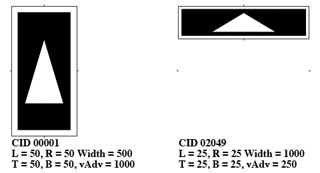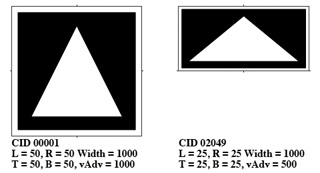CSS Half-Width Orientation Test and CSS Full-Width Orientation Test are special-purpose OpenType fonts that are based on the Adobe-Identity-0 ROS (ROS stands for /Registry, /Ordering, and /Supplement, and refers to the /CIDSystemInfo dictionary entries that define the glyph set name for CID-based character collections). The Adobe-Identity-0 ROS is a special-purpose character collection whose use is not tied to a specific language, and these are special-purpose OpenType fonts that are intended to render all Unicode code points using glyphs that indicate the glyph orientation based on the writing direction, thus the reason why the Adobe-Identity-0 ROS was chosen as the basis for this OpenType font.
These fonts include 2,050 glyphs (CIDs 0 through 2049), and map 1,111,998 Unicode code points to their 2,048 horizontal glyphs. CIDs 1 through 2048 are the horizontal glyphs, and are all the same. 2,048 glyphs are used for a more efficient (smaller) 'cmap' table size. CID+2049 is a single vertical glyph. The 2,048 High and Low Surrogates (U+D800 through U+DFFF), the two noncharacters in the BMP and in each of the 16 Supplementary Planes (FFFE and FFFF), and the 32 noncharacters in the range U+FDD0 through U+FDEF are explicitly and intentionally excluded. The 2,048 horizontal glyphs in each font map to a single vertical glyph via the 'vert' (Vertical Alternates) GSUB feature. As fully-functional OpenType fonts, the following 14 'sfnt' tables are included: CFF, DSIG, GSUB, OS/2, VORG, cmap, head, hhea, hmtx, maxp, name, post, vhea, and vmtx.
The images below show the functional glyphs in CSS Half-Width Orientation Test and CSS Full-Width Orientation Test (CID+1, the first of the 2,048 horizontal glyphs, and CID+2049, the single vertical glyph, are shown):
Note that within each OpenType font the vertical advance of the vertical glyph is one-half that of the horizontal advance of the horizontal glyphs, whose purpose is so that testing-automation scripts can more easily detect the glyph orientation and thus whether the 'vert' GSUB was applied correctly by measuring the metrics of the rendered text.
To build the binary font files from source, you need to have installed the Adobe Font Development Kit for OpenType (AFDKO). The AFDKO tools are widely used for font development today, and are part of most font editor applications.
In this repository, all necessary files are in place for building the OpenType/CFF fonts, and the COMMANDS.txt file provides the command lines that are used.
For any suggestions for changes, please create a new issue for consideration.

